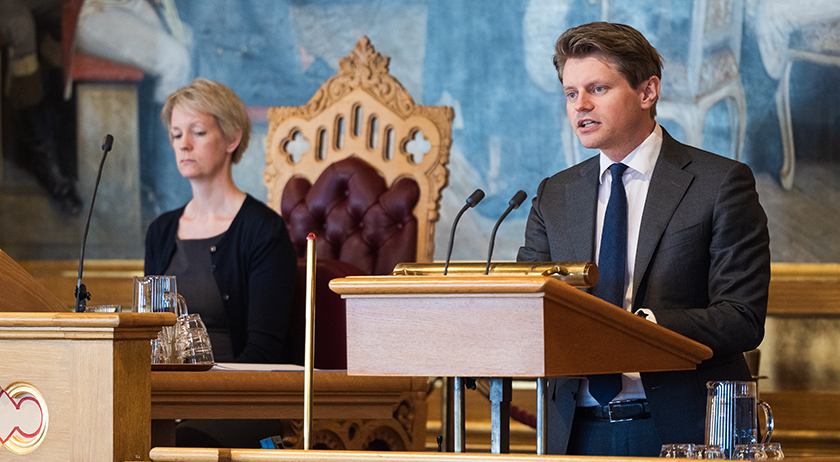
Peter Frølich (Conservative Party) speaking during the debate on constitutional amendments on 21st May. Photo: Storting
Amendments to the Constitution
On 21st May 2024, the Storting debated a number of draft amendments to the Norwegian Constitution. Among the motions considered was the proposal to give comprehensive constitutional protection to the law courts.
The motion was adopted; 168 Members voting in favour, with one MP absent. The constitutional amendments came into force with immediate effect.
Age limit for judges and maximum number of Supreme Court judges
The constitutional amendment that has now been adopted includes a number of important changes:
- The introduction of an age limit for Supreme Court judges means that it will not be possible to remove them from office before they reach the age of 70. This will make it difficult to lower the age limit through general legislation if the aim is to change the composition of judges.
- The Constitution shall state that there must be three courts of justice: the district courts, the courts of appeal and the Supreme Court. The Supreme Court and the Court of Impeachment have been mentioned in the Constitution since its adoption in 1814, but the Constitution now specifies that our justice system must take the form that it actually does.
- It is the responsibility of the state to ensure the independent administration of the courts.
- Without exception, judges must be nominated by an independent council before being appointed. This current practice will now be laid down in the Constitution. In this case, Norway will differ from the USA, for example, where these appointments are political.
- The Constitution shall state that there must be an upper limit to the number of Supreme Court judges. Before the amendment was adopted, it only said that there must be at least four judges in addition to the Chief Justice of the Supreme Court. In some countries, an ever-growing number of new judges have been appointed as a way of reducing the power of those already in place. This will not be possible in Norway after this constitutional amendment.
“The aim of these constitutional amendments is to make sure that we continue to be a liberal democracy in the future. We know that liberal democracy is currently on the retreat in the world. Our moves to give better protection to the independent courts is an important step in preventing such developments from happening in Norway. By doing this, we will make the abuse of power more difficult,” said Peter Frølich (Conservative Party), who had tabled the motion on the basis of a proposal from the Courts Commission.
121 articles
When the Norwegian Constitution was adopted by the Constituent Assembly at Eidsvoll on 17th May 1814, it comprised 110 articles. Today, there are 121 articles in the Constitution.
The proposals that were debated on 21st May had been put forward in one of the first three years of the previous parliamentary term. They were then considered in the Standing Committee on Scrutiny and Constitutional Affairs.
To be passed, constitutional amendments require a two-thirds majority to vote in favour of the proposals. In addition, at least two-thirds of the MPs must be present when the voting takes place. Unless the Storting decides otherwise, constitutional amendments enter into force with immediate effect; in other words, before they are officially announced.
Norway’s highest law source
The Constitution is the highest law source in Norway. If other laws or legal sources are in conflict with it, the Constitution takes precedence.
Last updated: 31.05.2024 15:51